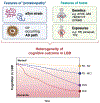Cognitive heterogeneity in Parkinson's disease: A mechanistic view
- PMID: 37028431
- PMCID: PMC10198897
- DOI: 10.1016/j.neuron.2023.03.021
Cognitive heterogeneity in Parkinson's disease: A mechanistic view
Abstract
Cognitive impairment occurs in most individuals with Parkinson's disease (PD), exacting a high toll on patients, their caregivers, and the healthcare system. In this review, we begin by summarizing the current clinical landscape surrounding cognition in PD. We then discuss how cognitive impairment and dementia may develop in PD based on the spread of the pathological protein alpha-synuclein (aSyn) from neurons in brainstem regions to those in the cortical regions of the brain responsible for higher cognitive functions, as first proposed in the Braak hypothesis. We appraise the Braak hypothesis from molecular (conformations of aSyn), cell biological (cell-to-cell spread of pathological aSyn), and organ-level (region-to-region spread of aSyn pathology at the whole brain level) viewpoints. Finally, we argue that individual host factors may be the most poorly understood aspect of this pathological process, accounting for substantial heterogeneity in the pattern and pace of cognitive decline in PD.
Keywords: Braak hypothesis; Lewy body; Parkinson’s disease; alpha-synuclein; cognition; dementia; dementia with Lewy bodies; mild cognitive impairment; strain.
Copyright © 2023 Elsevier Inc. All rights reserved.
Conflict of interest statement
Declaration of interests A.S.C.-P. is listed as an inventor on US patent application #20190328906 entitled “Therapy for Frontotemporal Dementia” from the Children’s Hospital of Philadelphia and the Trustees of the University of Pennsylvania and has received royalties from this patent. A.S.C.-P. is listed as an inventor on US provisional patent application no. 63/319,623 entitled “Methods for Treating Parkinson’s Disease” from the Trustees of the University of Pennsylvania. D.W. received honoraria in the past year for consultancy from Acadia Pharmaceuticals, Alkahest, Aptinyx, Cerevel Therapeutics, CHDI Foundation, Clintrex LLC (Otsuka), EcoR1 Capital, Eisai, Ferring, Gray Matter Technologies, Great Lake Neurotechnologies, Intra-Cellular Therapies, Janssen, Merck, Sage, Scion, and Signant Health. D.W. has received license fee payments from the University of Pennsylvania for the QUIP and QUIP-RS.
Figures



References
-
- McKeith IG, Boeve BF, Dickson DW, Halliday G, Taylor JP, Weintraub D, Aarsland D, Galvin J, Attems J, Ballard CG, et al. (2017). Diagnosis and management of dementia with Lewy bodies: Fourth consensus report of the DLB Consortium. Neurology 89, 88–100. 10.1212/WNL.0000000000004058. - DOI - PMC - PubMed
Publication types
MeSH terms
Substances
Grants and funding
LinkOut - more resources
Full Text Sources
Medical

